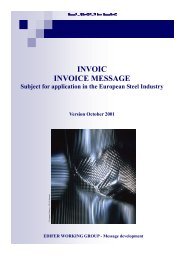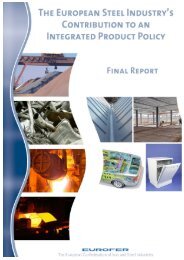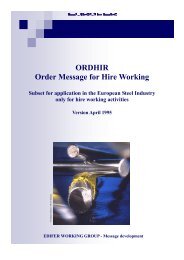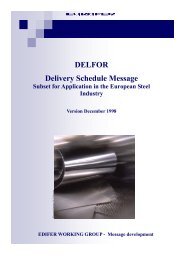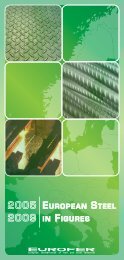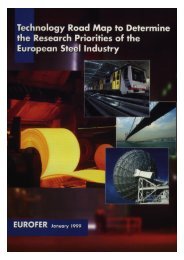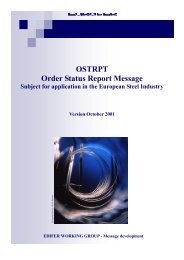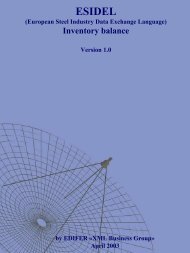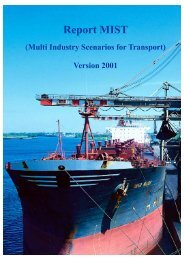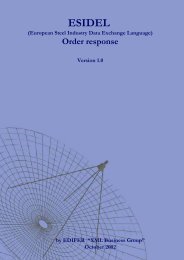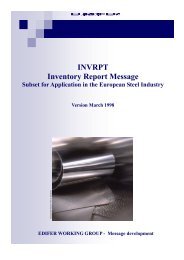manufacture, processing and use of stainless steel - International ...
manufacture, processing and use of stainless steel - International ...
manufacture, processing and use of stainless steel - International ...
Create successful ePaper yourself
Turn your PDF publications into a flip-book with our unique Google optimized e-Paper software.
Prolonged exposure<br />
Information on the effects <strong>of</strong> prolonged exposure to metallic <strong>stainless</strong> <strong>steel</strong> come from<br />
a number <strong>of</strong> animal implantation studies, where implantation <strong>of</strong> <strong>stainless</strong> <strong>steel</strong> items<br />
into muscle or sub-cutaneous tissue has resulted in a local response, characterised by<br />
inflammatory <strong>and</strong> fibrotic changes. These changes are considered to be a typical,<br />
non-specific local response to foreign material.<br />
Human data on the effects <strong>of</strong> prolonged exposure to metallic <strong>stainless</strong> <strong>steel</strong> are limited<br />
to a few case-reports in which local <strong>and</strong>/or distal effects have been reported in<br />
subjects who have received prosthetic implants made from <strong>stainless</strong> <strong>steel</strong>. However,<br />
these reports have not provided consistent evidence <strong>of</strong> an association between<br />
<strong>stainless</strong> <strong>steel</strong> <strong>and</strong> the reported changes over <strong>and</strong> above a non-specific response to<br />
implanted materials. Further, given the wide <strong>use</strong> <strong>of</strong> <strong>stainless</strong> <strong>steel</strong> in prosthetic<br />
devices, surgical <strong>and</strong> dental, it is highly significant that only a small number <strong>of</strong> cases<br />
have been reported.<br />
Consideration against classification criteria: Only limited animal <strong>and</strong> human data<br />
are available. These provide no evidence that prolonged exposure to metallic<br />
<strong>stainless</strong> <strong>steel</strong>s has any serious detrimental effect on health. There is no basis for<br />
classifying metallic <strong>stainless</strong> <strong>steel</strong>s for effects arising from repeated or prolonged<br />
exposure.<br />
Carcinogenicity<br />
The only data relating to the carcinogenicity <strong>of</strong> metallic <strong>stainless</strong> <strong>steel</strong> comes from a<br />
single animal study in which i.m. implantation <strong>of</strong> <strong>stainless</strong> <strong>steel</strong> rods failed to increase<br />
tumour development in mice. No st<strong>and</strong>ard animal carcinogenicity studies have been<br />
conducted with metallic <strong>stainless</strong> <strong>steel</strong> using recommended protocols, although this is<br />
not surprising given the problems that would be faced exposing animals to the test<br />
material.<br />
There are no data available regarding the carcinogenicity <strong>of</strong> metallic <strong>stainless</strong> <strong>steel</strong>s in<br />
humans.<br />
Consideration against classification criteria: The available data provide no basis for<br />
classifying metallic <strong>stainless</strong> <strong>steel</strong>s for carcinogenicity.<br />
Mutagenicity<br />
No data are available relating to the mutagenicity <strong>of</strong> metallic <strong>stainless</strong> <strong>steel</strong>, although<br />
this is not unexpected given the difficulties that would be encountered in conducting<br />
tests using currently available methods.<br />
Consideration against classification criteria: In the absence <strong>of</strong> any data, there is no<br />
basis for classifying metallic <strong>stainless</strong> <strong>steel</strong>s for mutagenicity.<br />
24



